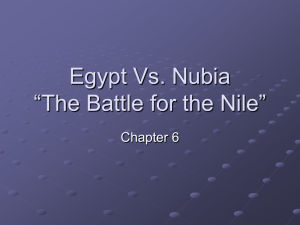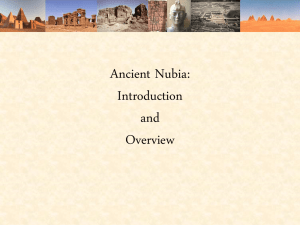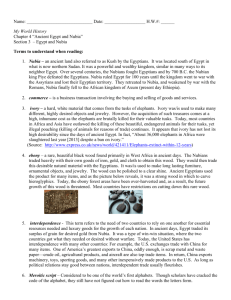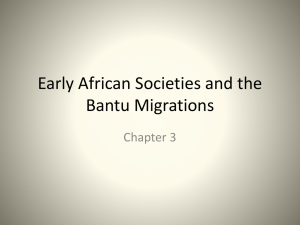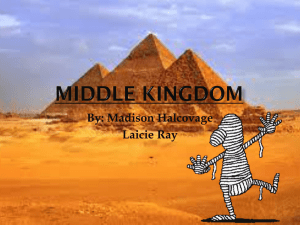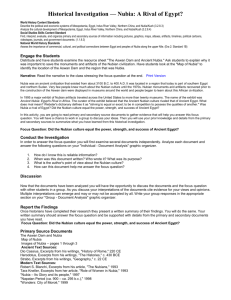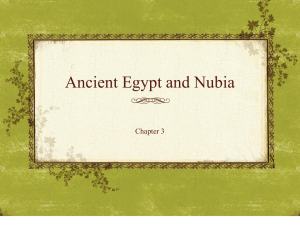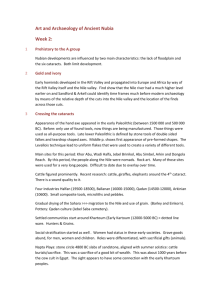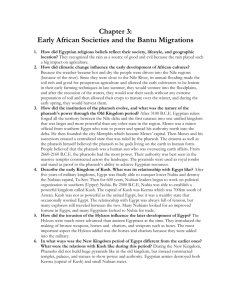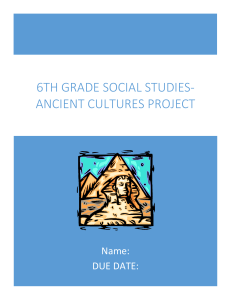Lesson Plans: SS WHis LPQ1 039 Nubia: Land of the Bow
advertisement
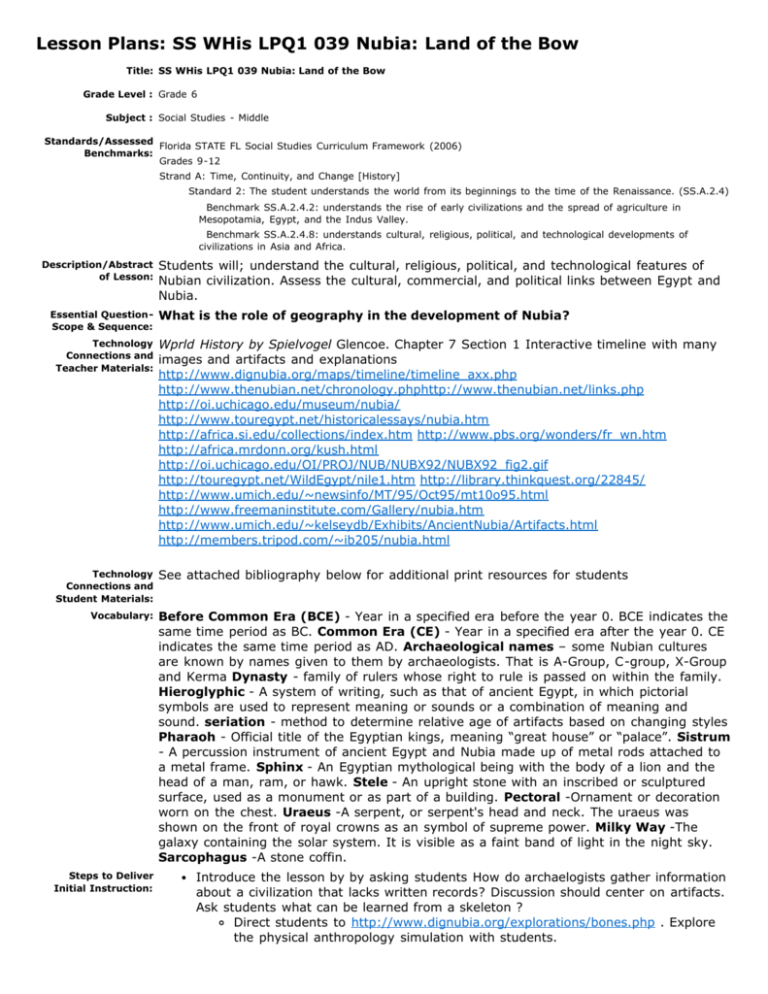
Lesson Plans: SS WHis LPQ1 039 Nubia: Land of the Bow Title: SS WHis LPQ1 039 Nubia: Land of the Bow Grade Level : Grade 6 Subject : Social Studies - Middle Standards/Assessed Florida STATE FL Social Studies Curriculum Framework (2006) Benchmarks: Grades 9-12 Strand A: Time, Continuity, and Change [History] Standard 2: The student understands the world from its beginnings to the time of the Renaissance. (SS.A.2.4) Description/Abstract of Lesson: Essential QuestionScope & Sequence: Benchmark SS.A.2.4.2: understands the rise of early civilizations and the spread of agriculture in Mesopotamia, Egypt, and the Indus Valley. Benchmark SS.A.2.4.8: understands cultural, religious, political, and technological developments of civilizations in Asia and Africa. Students will; understand the cultural, religious, political, and technological features of Nubian civilization. Assess the cultural, commercial, and political links between Egypt and Nubia. What is the role of geography in the development of Nubia? Technology Connections and Teacher Materials: Wprld History by Spielvogel Glencoe. Chapter 7 Section 1 Interactive timeline with many images and artifacts and explanations http://www.dignubia.org/maps/timeline/timeline_axx.php http://www.thenubian.net/chronology.phphttp://www.thenubian.net/links.php http://oi.uchicago.edu/museum/nubia/ http://www.touregypt.net/historicalessays/nubia.htm http://africa.si.edu/collections/index.htm http://www.pbs.org/wonders/fr_wn.htm http://africa.mrdonn.org/kush.html http://oi.uchicago.edu/OI/PROJ/NUB/NUBX92/NUBX92_fig2.gif http://touregypt.net/WildEgypt/nile1.htm http://library.thinkquest.org/22845/ http://www.umich.edu/~newsinfo/MT/95/Oct95/mt10o95.html http://www.freemaninstitute.com/Gallery/nubia.htm http://www.umich.edu/~kelseydb/Exhibits/AncientNubia/Artifacts.html http://members.tripod.com/~ib205/nubia.html Technology Connections and Student Materials: See attached bibliography below for additional print resources for students Vocabulary: Steps to Deliver Initial Instruction: Before Common Era (BCE) - Year in a specified era before the year 0. BCE indicates the same time period as BC. Common Era (CE) - Year in a specified era after the year 0. CE indicates the same time period as AD. Archaeological names – some Nubian cultures are known by names given to them by archaeologists. That is A-Group, C-group, X-Group and Kerma Dynasty - family of rulers whose right to rule is passed on within the family. Hieroglyphic - A system of writing, such as that of ancient Egypt, in which pictorial symbols are used to represent meaning or sounds or a combination of meaning and sound. seriation - method to determine relative age of artifacts based on changing styles Pharaoh - Official title of the Egyptian kings, meaning “great house” or “palace”. Sistrum - A percussion instrument of ancient Egypt and Nubia made up of metal rods attached to a metal frame. Sphinx - An Egyptian mythological being with the body of a lion and the head of a man, ram, or hawk. Stele - An upright stone with an inscribed or sculptured surface, used as a monument or as part of a building. Pectoral -Ornament or decoration worn on the chest. Uraeus -A serpent, or serpent's head and neck. The uraeus was shown on the front of royal crowns as an symbol of supreme power. Milky Way -The galaxy containing the solar system. It is visible as a faint band of light in the night sky. Sarcophagus -A stone coffin. Introduce the lesson by by asking students How do archaelogists gather information about a civilization that lacks written records? Discussion should center on artifacts. Ask students what can be learned from a skeleton ? Direct students to http://www.dignubia.org/explorations/bones.php . Explore the physical anthropology simulation with students. Write three terms absolute dates, relative dates and seriation on the board. Ask students to guess at their signifcance. Absolute dates can be determined by Carbon dating and other methods. Relative age is useful in ordering artifacts in relation to each era or time period. This is called seriation. Direct students to http://www.dignubia.org/explorations/seriation.php Explore seriation simulation with students. Have students come up with their own examples of artifacts that could be chronologically ordered Following the 2 simulations, each student should write a short summary explaining the significance of artifacts in obtaining information about Nubia. Guided Practice with Feedback: Independent Practice: The Rise of Nubia and Egypt: Developing the ability to compare within and among societies. Review the definition and characteristics of the term “civilization.” Students discuss and list any prior information about both civilizations. Students can speculate on why so much is known of Egypt compared to Nubia. Students will complete maps identifying the borders of Egypt and Nubia and capital cities. They will identify significant political factors like dynastic periods and economic factors like trade routes. They will also identify the following places and explain their significance to both Egypt and Nubia. Nile River, Nile Delta, Mediterranean Sea, Red Sea, Sahara Using the maps students will reflect on how geographical factors influenced the nature of the relationship between Egypt and Nubia. Students will conduct research to characterize the relationship, for example Egypt exploited Nubia for its resources and labor. Nubia was also an important link between Egypt and Central Africa. Each student will write a one paragraph summary on the general nature of the relationship between Egypt and Nubia. Differentiated Instruction/Small Groups: The Gift of the Nile” vs “The Land of the Bow” To have students develop an in depth comparison of the contributions of Egypt and Nubia. Divide the class into four groups. Each group will choose either Egypt or Nubia with two groups working on each civilization. Each group will further subdivide into expert groups to research the following information: Historical summary – origin and end date with ten important events on timeline. Government – type, structure, significant laws. Society – class structure, women’s role, rights, customs. Achievements – inventions, adaptations. Important people – specific people with achievements. Terminology – key terms specific to that civilization. After all research has been completed the expert groups will meet to check the accuracy of their work and complete a matrix. Teams will meet and present their findings to the class. Example of matrix: Research Government Society Achievements Terminology Important People Lesson Closure/Review: Nubia Egypt Students will create a newspaper using the information they have gathered. The newspaper should model the Ft Pierce Tribune in having a number of sections. Each group should select at least three sections for their paper National News - Information about the government, National disasters International News - Treaties, Diplomatic issues, visits, Interactions with other countries, trade Travel and Leisure - Places to visit, sites to see – must be time specific Sports - Events that are time specific Health and Food - Recipes, Health care Arts and Culture - Events, music, festivals, art Weather - seasons Classifieds - Advertise items that are time specific Creator : HS SS Content Team File Attachments: Bibliography for students.pdf nubia_cassius98.pdf nubia_glory95.pdf nubia_herodotus48.pdf nubia_images99.pdf nubia_map92.pdf nubia_napatan75.pdf nubia_strabo24.pdf nubia_wonders95.pdf Date Created : March 11, 2008 Date Modified : November 29, 2011
